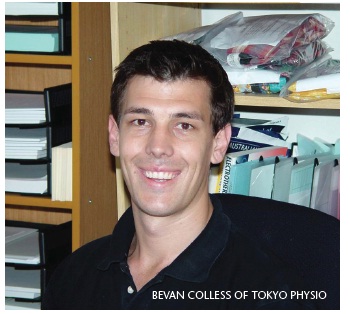by Bevan Colless
While central Tokyo may not be the most sports-friendly location in the world, with a little extra planning and effort, you can practice pretty much any sport you like. Soccer, tennis, rugby, skiing, running and triathlons are some of the most popular amongst the expatriate community in Tokyo. However with sports, inevitably, comes injury. So when the body breaks down from overuse or an acute injury, what does one do?
Sports injuries can be divided into acute and chronic injuries. Acute injuries have a definite mechanism of injury, such as a sprained ankle or twisted knee. Chronic injuries come on insidiously and are often overuse injuries.
For acute injuries remember the RICE rule of treatment for the first 24–48 hours, or longer for more severe cases.
Rest: from aggravating conditions
Ice: for about 10–20 minutes several times daily
Compression: using an elastic bandage or tubi-grip
Elevation: above the heart is a good rule of thumb
It’s also good to avoid the H.A.R.M factors.
Heat: stay out of the onsen
Alcohol: avoid the booze, it’s a vaso-dilator (increasing blood flow) and will increase swelling and inflammation
Running: stay away from exercise for the short term
Massage: avoid deep massage in the early stages
Chronic and overuse injuries are often more challenging to manage. A detailed assessment of the injury and the aggravating factors is essential in resolving these issues and often require a considered approach taking into account all aspects of the patient’s history and condition. This type of assessment is best provided by a sports medicine specialist, such as a sports Doctor or Physiotherapist.
Sports medicine in Japan is still a relatively new field of medicine and if you are not a professional athlete there is often little sympathy for injuries that allow you to live your life as normal but prevent you playing sports. The Japanese National Health system is so common and private health insurance in Japan is quite rare which often means that a return to full function is often not a priority. Let’s take the example of a runner who is training for the Tokyo marathon that begins to experience knee pain after two hours of running. The patient will often present their problem to a doctor who may decide to take an X-ray that will most likely appear normal which, as long as you don’t run for two hours, it is. In this case a physiotherapist is in an ideal position to provide solutions to get this runner to the finish line.
Physiotherapy (Physical Therapy) is a form of rehabilitation using a variety of conservative techniques aimed at return to full function and normal activity. A session with a physiotherapist should involve a thorough breakdown on the history of the condition, including the current and prior presentation, aggravating and easing factors and a discussion of the patient’s goals. This will be followed by a physical assessment involving taking measurements of movement to assess progress. An explanation of the condition and a treatment plan should be formulated.
Physiotherapy treatment will often involve massage, electro-therapy, joint mobilizations and manipulations, clinic-based exercise program and finally the formulation of a plan to self-manage the problem. Physiotherapy is used to assess and treat back and neck pain, sporting injuries, rehabilitation after operations, joint pain, headaches, women’s health and developmental problems with children. A doctor’s referral is not necessary before visiting a physiotherapist; however some international insurance companies do require a referral to pay for treatment. The Japanese National Health Insurance can only be used in physiotherapy clinics that are owned by Doctors. For any further questions please contact Tokyo Physio at 03-3443-6769.
Bevan Colless is a Tokyo based Physiotherapist and with his wife Vanessa, co-founders of Tokyo Physio.










